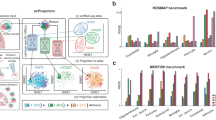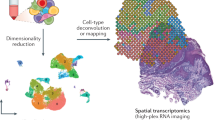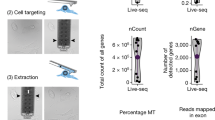Abstract
Transcriptome profiling of single cells resident in their natural microenvironment depends upon RNA capture methods that are both noninvasive and spatially precise. We engineered a transcriptome in vivo analysis (TIVA) tag, which upon photoactivation enables mRNA capture from single cells in live tissue. Using the TIVA tag in combination with RNA sequencing (RNA-seq), we analyzed transcriptome variance among single neurons in culture and in mouse and human tissue in vivo. Our data showed that the tissue microenvironment shapes the transcriptomic landscape of individual cells. The TIVA methodology is, to our knowledge, the first noninvasive approach for capturing mRNA from live single cells in their natural microenvironment.
This is a preview of subscription content, access via your institution
Access options
Subscribe to this journal
Receive 12 print issues and online access
$259.00 per year
only $21.58 per issue
Buy this article
- Purchase on Springer Link
- Instant access to full article PDF
Prices may be subject to local taxes which are calculated during checkout






Similar content being viewed by others
Accession codes
References
Kaern, M., Elston, T.C., Blake, W.J. & Collins, J.J. Stochasticity in gene expression: from theories to phenotypes. Nat. Rev. Genet. 6, 451–464 (2005).
Raj, A. & van Oudenaarden, A. Nature, nurture, or chance: stochastic gene expression and its consequences. Cell 135, 216–226 (2008).
Eldar, A. & Elowitz, M.B. Functional roles for noise in genetic circuits. Nature 467, 167–173 (2010).
Elowitz, M.B., Levine, A.J., Siggia, E.D. & Swain, P.S. Stochastic gene expression in a single cell. Science 297, 1183–1186 (2002).
Flatz, L. et al. Single-cell gene-expression profiling reveals qualitatively distinct CD8 T cells elicited by different gene-based vaccines. Proc. Natl. Acad. Sci. USA 108, 5724–5729 (2011).
Taniguchi, Y. et al. Quantifying E. coli proteome and transcriptome with single-molecule sensitivity in single cells. Science 329, 533–538 (2010).
Pedraza, J.M. & van Oudenaarden, A. Noise propagation in gene networks. Science 307, 1965–1969 (2005).
Cahoy, J.D. et al. A transcriptome database for astrocytes, neurons, and oligodendrocytes: a new resource for understanding brain development and function. J. Neurosci. 28, 264–278 (2008).
Lovatt, D. et al. The transcriptome and metabolic gene signature of protoplasmic astrocytes in the adult murine cortex. J. Neurosci. 27, 12255–12266 (2007).
Sugino, K. et al. Molecular taxonomy of major neuronal classes in the adult mouse forebrain. Nat. Neurosci. 9, 99–107 (2006).
Eberwine, J. et al. Quantitative biology of single neurons. J. R. Soc. Interface 9, 3165–3183 (2012).
Espina, V. et al. Laser-capture microdissection. Nat. Protoc. 1, 586–603 (2006).
Tang, F. et al. mRNA-seq whole-transcriptome analysis of a single cell. Nat. Methods 6, 377–382 (2009).
Okaty, B.W., Sugino, K. & Nelson, S.B. A quantitative comparison of cell-type-specific microarray gene expression profiling methods in the mouse brain. PLoS ONE 6, e16493 (2011).
Joliot, A. & Prochiantz, A. Transduction peptides: from technology to physiology. Nat. Cell Biol. 6, 189–196 (2004).
Kumar, P. et al. Transvascular delivery of small interfering RNA to the central nervous system. Nature 448, 39–43 (2007).
Zeng, F. et al. A protocol for PAIR: PNA-assisted identification of RNA binding proteins in living cells. Nat. Protoc. 1, 920–927 (2006).
Zielinski, J. et al. In vivo identification of ribonucleoprotein-RNA interactions. Proc. Natl. Acad. Sci. USA 103, 1557–1562 (2006).
Adams, S.R. & Tsien, R.Y. Controlling cell chemistry with caged compounds. Annu. Rev. Physiol. 55, 755–784 (1993).
Tang, X. & Dmochowski, I.J. Synthesis of light-activated antisense oligodeoxynucleotide. Nat. Protoc. 1, 3041–3048 (2006).
Dmochowski, I.J. & Tang, X. Taking control of gene expression with light-activated oligonucleotides. Biotechniques 43, 161–165 (2007).
Madani, F., Lindberg, S., Langel, U., Futaki, S. & Graslund, A. Mechanisms of cellular uptake of cell-penetrating peptides. J. Biophys. 2011, 414729 (2011).
Svensen, N., Walton, J.G. & Bradley, M. Peptides for cell-selective drug delivery. Trends Pharmacol. Sci. 33, 186–192 (2012).
Roy, R., Hohng, S. & Ha, T. A practical guide to single-molecule FRET. Nat. Methods 5, 507–516 (2008).
Eberwine, J. et al. Analysis of gene expression in single live neurons. Proc. Natl. Acad. Sci. USA 89, 3010–3014 (1992).
Morris, J., Singh, J.M. & Eberwine, J.H. Transcriptome analysis of single cells. J. Vis. Exp. 2011, 2634 (2011).
Ramskold, D. et al. Full-length mRNA-Seq from single-cell levels of RNA and individual circulating tumor cells. Nat. Biotechnol. 30, 777–782 (2012).
Griffith, M. et al. Alternative expression analysis by RNA sequencing. Nat. Methods 7, 843–847 (2010).
Zheng, W., Chung, L.M. & Zhao, H. Bias detection and correction in RNA-Sequencing data. BMC Bioinformatics 12, 290 (2011).
Adiconis, X. et al. Comparative analysis of RNA sequencing methods for degraded or low-input samples. Nat. Methods 10, 623–629 (2013).
Gertz, J. et al. Transposase mediated construction of RNA-seq libraries. Genome Res. 22, 134–141 (2012).
Ellis-Davies, G.C. Caged compounds: photorelease technology for control of cellular chemistry and physiology. Nat. Methods 4, 619–628 (2007).
Zhang, S.C. Defining glial cells during CNS development. Nat. Rev. Neurosci. 2, 840–843 (2001).
Pribyl, T.M. et al. Expression of the myelin basic protein gene locus in neurons and oligodendrocytes in the human fetal central nervous system. J. Comp. Neurol. 374, 342–353 (1996).
Landry, C.F. et al. Myelin basic protein gene expression in neurons: developmental and regional changes in protein targeting within neuronal nuclei, cell bodies, and processes. The J. Neurosci. 16, 2452–2462 (1996).
Vives, V., Alonso, G., Solal, A.C., Joubert, D. & Legraverend, C. Visualization of S100B-positive neurons and glia in the central nervous system of EGFP transgenic mice. J. Comp. Neurol. 457, 404–419 (2003).
West, A.E., Griffith, E.C. & Greenberg, M.E. Regulation of transcription factors by neuronal activity. Nat. Rev. Neurosci. 3, 921–931 (2002).
Turner, J.J. et al. Cell-penetrating peptide conjugates of peptide nucleic acids (PNA) as inhibitors of HIV-1 Tat-dependent trans-activation in cells. Nucleic Acids Res. 33, 6837–6849 (2005).
Richards, J.L., Tang, X., Turetsky, A. & Dmochowski, I.J. RNA bandages for photoregulating in vitro protein synthesis. Bioorg. Med. Chem. Lett. 18, 6255–6258 (2008).
Cummings, D.D., Wilcox, K.S. & Dichter, M.A. Calcium-dependent paired-pulse facilitation of miniature EPSC frequency accompanies depression of EPSCs at hippocampal synapses in culture. J. Neurosci. 16, 5312–5323 (1996).
Grant, G.R. et al. Comparative analysis of RNA-Seq alignment algorithms and the RNA-Seq unified mapper (RUM). Bioinformatics 27, 2518–2528 (2011).
Anders, S. & Huber, W. Differential expression analysis for sequence count data. Genome Biol. 11, R106 (2010).
Acknowledgements
We thank J. Cheung-Lau for assistance with in vitro FRET measurements. Funding was provided by the PhRMA foundation to D.L., US National Institutes of Health (NIH) R01 GM083030 to I.J.D., McKnight Foundation Technology Innovations Award to I.J.D. and J.E., U01MH098953 to J.K. and J.E. and NIH DP004117 to J.E. This project is funded, in part, by the Penn Genome Frontiers Institute under a grant with the Pennsylvania Department of Health, which disclaims responsibility for any analyses, interpretations or conclusions.
Author information
Authors and Affiliations
Contributions
All authors contributed to the writing of the manuscript. D.L. performed dispersed-cell TIVA experiments and some computational analysis; B.K.R. contributed TIVA-tag characterization and supplied TIVA tag; J.L. perfomed slice experiments and the bulk of TIVA uncaging; H.D. performed the bulk of the computational analysis; T.K.K. performed TIVA-mediated RNA amplifications; S.F. contributed computational analysis; C.F. contributed some control samples; J.M.S. contributed TIVA-mediated RNA amplifications; J.A.W., M.S.G. and A.V.U. organized human tissue use; S.B.Y. and J.C.G. contributed TIVA tag; P.T.B. contributed TIVA-mediated RNA amplifications; J.K. directed the computational analysis; J.Y.S. contributed the TIVA uncaging parameters and oversaw the biophotonics; I.J.D. designed experiments and contributed oversight of TIVA-tag synthesis; J.E. designed experiments and contributed oversight of the biological experiments.
Corresponding author
Ethics declarations
Competing interests
The authors declare no competing financial interests.
Supplementary information
Supplementary Text and Figures
Supplementary Figures 1–8 and Supplementary Tables 1, 2, 4 and 5 (PDF 4202 kb)
Supplementary Table 3
Environment specific expressed genes in single neurons from culture vs. tissue (XLSX 293 kb)
Supplementary Table 6
List of 645 bimodal genes (XLSX 76 kb)
Rights and permissions
About this article
Cite this article
Lovatt, D., Ruble, B., Lee, J. et al. Transcriptome in vivo analysis (TIVA) of spatially defined single cells in live tissue. Nat Methods 11, 190–196 (2014). https://doi.org/10.1038/nmeth.2804
Received:
Accepted:
Published:
Issue Date:
DOI: https://doi.org/10.1038/nmeth.2804
This article is cited by
-
Photoselective sequencing: microscopically guided genomic measurements with subcellular resolution
Nature Methods (2023)
-
Femtosecond laser microdissection for isolation of regenerating C. elegans neurons for single-cell RNA sequencing
Nature Methods (2023)
-
Subcellular omics: a new frontier pushing the limits of resolution, complexity and throughput
Nature Methods (2023)
-
High-depth spatial transcriptome analysis by photo-isolation chemistry
Nature Communications (2021)
-
Statistical analysis of spatial expression patterns for spatially resolved transcriptomic studies
Nature Methods (2020)



